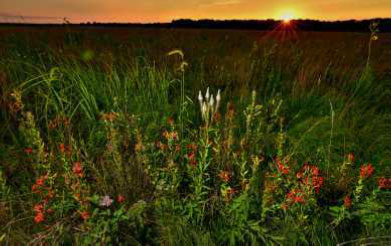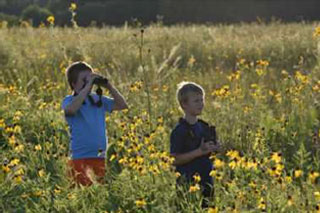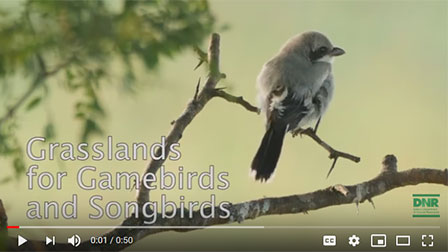Main Content
Article
Grasslands for Gamebirds and Songbirds Initiative
Would you like more quail on your property? Do you want to hear the calls of songbirds in your area? Are you concerned about water quality or pollinators? If so, consider joining the Grasslands for Gamebirds and Songbirds Initiative (GGS). The program provides technical and financial assistance to improve or develop grassland and pollinator-friendly habitats in selected regions in the state.

Grasslands are declining across Indiana and throughout the nation. The 2015 Indiana State Wildlife Action Plan identified the percentage of grassland habitat loss as the largest habitat decline in Indiana. Many grassland bird populations are already showing significant decline. The loss of pollinating insects and the plants they depend are also a growing concern addressed by this program. Pollinators are important not only for wildlife, but for the health of human populations. Estimates suggest that one in three bites of food consumed worldwide are directly linked to pollination from floral/faunal relationships.
Improving and expanding grasslands will increase populations of:
- Northern bobwhite.
- Henslow’s sparrows.
- Loggerhead shrike.
- Ring-necked pheasants.
- Other grassland species.

How GGS works
GGS is a partnership with other conservation agencies including DNR, USDA Natural Resources Conservation Service, Natural Resources Foundation, non-profit conservation groups, private industries and other sponsors to:
- Develop and improve grasslands and pollinator habitats in targeted areas in Indiana.
- Improve soil health and water quality.
- Improve species diversity.
- Increase hunting, birding and outdoor recreation opportunities.
- Improve overall human health.
- Increase funding to local economies.
- Preserve cultural heritage.
Grasslands for Gamebirds & Songbirds (GGS) program biologists can visit your property and provide technical assistance about how to better manage your property for grassland and pollinator species.

Whether your interest is helping pollinators, wildlife viewing, gamebird hunting, or conservation-minded land management, GGS can benefit you as a landowner. Grassland Biologists can create a customized plan to help you manage your property to maximize benefits to wildlife and the environment.
Voluntary Opportunity for Additional Financial Incentives
There is also potential to expand opportunities for recreation and landowner assistance through the Indiana Private Lands Access Program (IPLA – formerly known as APPLE). This program offers additional financial incentives to landowners who allow controlled public access hunting on their private lands. Landowners and hunters interested in learning more about IPLA can check here.
*GGS participants may be eligible but are not required to participate in IPLA.
Eligible GGS areas
GGS targets five key areas of the state known as Focal Regions. These regions have been selected based on such factors as existing quail or ring-necked pheasant habitat and potential for habitat establishment and connectivity throughout a region. Data and guidance from the National Bobwhite Conservation Initiative and the National Wild Pheasant Conservation Plan was also used to identify focal regions.
- Focal Region 1 (west central Indiana): Sullivan and Daviess counties, Greene County west of U.S. 231, Clay County south of U.S. 40
- Focal Region 2 (southwest Indiana): Gibson, Pike, Warrick, and Spencer counties.
- Focal Region 3 (southeast Indiana): Ripley and Scott counties, Jackson and Jennings counties south of US 50.
- Focal Region 4 (northwest Indiana): Benton and White counties, Jasper and Newton counties south of State Road 10, Warren County north of State Road 28
- Focal Region 5 (northeast Indiana): All of LaGrange, Steuben, Noble and Dekalb counties.
How to join
Contact:
- Nate Yazel, Southeast Grassland Biologist, 812-718-4117. nyazel@dnr.IN.gov
- Emily Jacob, Southwest Grassland Biologist, 812-512-9157, ejacob@dnr.IN.gov
- Adam Delucenay, North Grassland Biologist, 260-788-0336, adelucenay@dnr.IN.gov
How to help
To make the program a success, you can help by donating $5 to $50,000 or more to create quality grassland and pollinator habitats. Your donation helps fund the GGS program directly since all donations are used as matching funds to leverage additional monies.
- Northern Bobwhite Sponsor (Gold Level) $50,000 and up
- Ring-necked Pheasant Sponsor (Silver Level) $25,000 to $49,999
- Loggerhead Shrike Sponsor (Bronze Level) $5,000 to $24,999
- Prairie Chicken Level Sponsor
All levels receive recognition in Wild Bulletin, our monthly e-newsletter (475,000 subscribers)
How to donate
Donations are tax-deductible.
- Online. Make an immediate donation through the Indiana Natural Resources Foundation website by using this form. Type GGS in the “In Honor/Memory Of” box at the bottom of the form for proper routing.
- Mail. Send a check or money order, made payable to Indiana Natural Resources Foundation. Denote GGS in the memo for proper routing. Address:
Grasslands for Gamebirds and Songbirds
402 W. Washington St, W273
Indianapolis, IN 46204
For more information, contact Josh Griffin at jgriffin@dnr.IN.gov or 317-234-9737

